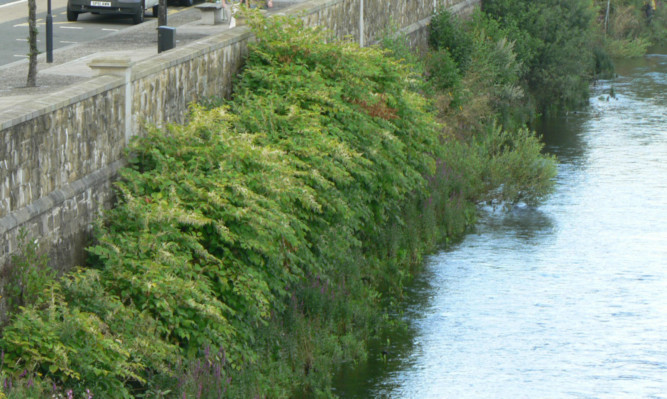A MAJOR effort is under way to eliminate an invasive alien plant species from riverbanks throughout Perthshire.
The Tay Salmon Fisheries Board wants to see an end to the Japanese knotweed that has plagued the River Earn, in particular, crowding out native plant species and detrimentally affecting biodiversity and river ecology.
It is one of three aggressive species along with Himalayan balsam and giant hogweed that have troubled the Tay, Earn, Isla, Eden and Tummel in recent years.
Each is extremely tenacious and hugely difficult to combat and remove, but there is now the hope that, with grant funding, Japanese knotweed could cease to be a problem within five years.
The species was introduced into Britain in the 19th century as an ornamental plant, but over time it has become widespread in a range of habitats, including roadsides, riverbanks and derelict buildings.
It can grow a metre in less than a month and out-competes native plants and animals, damaging the local landscape.
In 2010 and 2011, contractors were engaged by the Tay Foundation to spray Japanese knotweed on the River Earn, with most of the knotweed between St Fillans and Auchterarder sprayed once.
Part of the same area was resprayed in 2012 and such action may be required several times more to eliminate the plant.
Even once the Japanese knotweed finally stops growing back, the soil it inhabited may have to be removed due to the presence of particles left behind.
As the Tay Foundation’s original grant from Esme Fairbairn Foundation had been used up, in 2012 the spraying was paid for jointly by the Tay Foundation and the River Earn Improvement Association.
Recently, Rivers and Fisheries Trusts of Scotland (RAFTS), the umbrella body for Scottish fishery trusts, has submitted an application for EU funding for a national five-year project for the removal of selected freshwater and aquatic invasive species, like knotweed.
This is being backed by significant matched funding from SEPA and SNH and, if successful, the project will deliver significant resources to control Japanese knotweed and some other invasive species between 2013 and 2018.
The Tay Salmon Fisheries Board is set to take the lead on those eradication efforts locally.
At the board’s recent annual general meeting, it was proposed that a dedicated officer be employed by RAFTS to coordinate work in the Tay district.
Members said such a commitment would give the issue “the true degree of focus it requires”.
Building on the work that has already started, it is hoped that by 2018 Japanese knotweed will be entirely eliminated from the riparian zone of the River Earn and from other parts of the district where it is, as yet, less prolific.
mmackay@thecourier.co.uk
